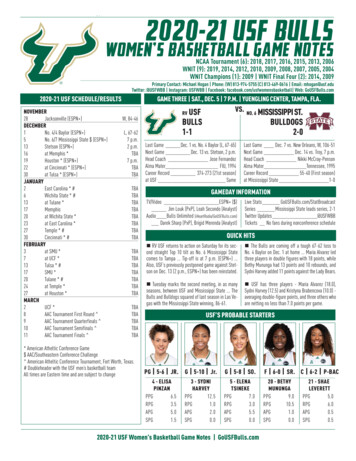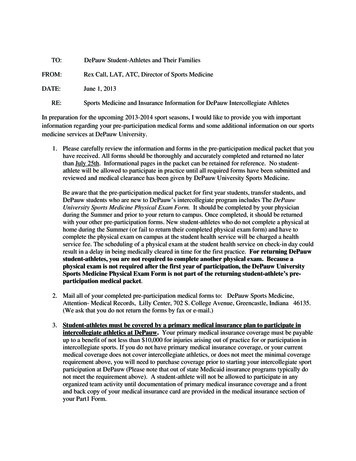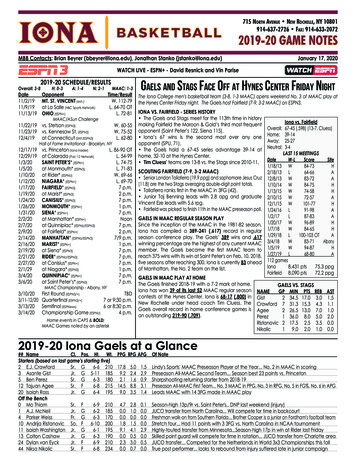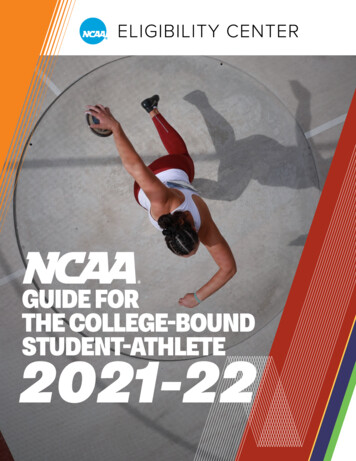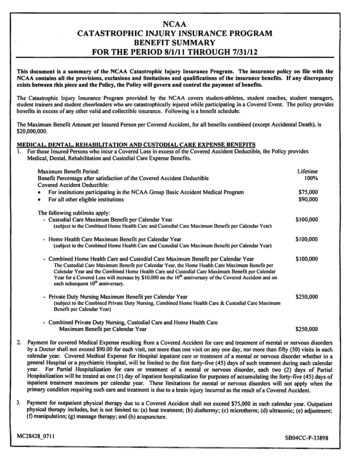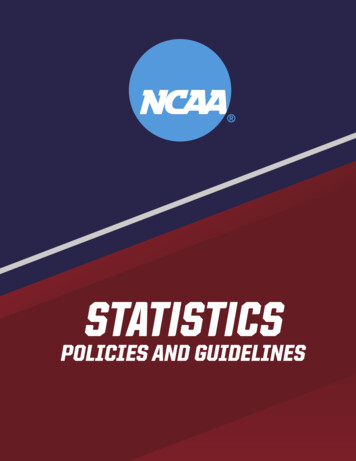
Transcription
StatisticsPOLICIES AND GUIDELINES
CONTENTSIntroduction 3NCAA Statistics Compilation Guidelines 3First Year of Statistics by Sport 4School Code 4Countable Opponents 5Definition 5Non-Countable Opponents 5Sport Implementation 5Rosters 6Head Coach Determination 6Co-Head Coaches 7Submitting Rosters 7Class Listing in Rosters 8Death of a Student-Athlete or Head Coach 8Student-Athletes Dismissed from Team 8Schedules 9Exhibition Games 9Home/Away/Neutral Site Contests 9Entering Schedules 11Submitting Statistics 12Submitting Single-Game Stat Files 12Reporting Statistics Regularly 12Substantiation of Statistics 12Playing Rules 12Attendance Figures 12Length of Contests 13Extra-Inning, Extra-Period or Overtime Contests 13Suspended Contests 131
Official Statistics 14Career Statistics 14Football Statistics 15Changing Official Statistics 15Postseason Records and Statistics 16National Rankings 16Declared Champions 16Ranking Minimums 17Statistical Rankings 17Records 18Coaches’ Minimum-Seasons Requirement to Rank 18Consensus All-America Teams 18Double-Doubles in Basketball 19Streaks 19Stat Plaques 19Eligibility 20Ineligible Athletes 20Team Minimum-Games Requirement 20Provisional Teams in Rating Percentage Index/NET and Statistics 20Reclassifying Teams in Rating Percentage Index/NET and Statistics 20Forfeits and Vacancies 21Forfeits and Vacancies 21Forfeit Scores 22“No Contest” Declaration 23Appendix A — Statistical Plaque Categories 24Index 282
NCAA STATISTICS POLICIES AND GUIDELINESIntroductionINTRODUCTIONThe following compilation of statistics service policies and guidelines should not be considered a definitivelist. Some of the information is taken directly from the NCAA Manuals and additional material is includedto help clarify inquiries the staff receives during the year. Sports information directors are encouraged toalert us to other areas not covered in this document that could be added to future versions. Feel free to callor email any time you have questions or concerns. Click here to see who to contact.NCAA STATISTICS COMPILATION GUIDELINESAll statistics reported to the NCAA should be compiled by the host institution press box/row statisticsstaff during the contest. Any exceptions to these guidelines must clearly be documented with rationaleprovided, explaining why in-contest statistics were not available. Numbers compiled by a coaching staffor other university/college personnel using game film after the fact will not be considered “official” NCAAstatistics.This does not preclude a conference or institution from making after-the-contest changes to press box/rownumbers. This is consistent with existing NCAA statistics policies involving corrections to any statisticsafter a contest. Any changes to press box/row numbers must be obvious errors such as misidentifiedplayers and this should not be interpreted as a way for press box/row statistics to later be “updated” bycoaching films.Judgment calls made by the official statistician are NOT subject to change once the contest statistics havebeen ruled final unless a sport’s official rules of the game specify different deadlines (e.g., 24 hours forbaseball or softball).Home statisticians are encouraged to consult with the visiting SID or coaching staff if a particular scoringplay or statistical interpretation can better be clarified by understanding the team’s intent or philosophy.Ideally, this will allow for any subsequent change in the statistics to be made prior to the team’s departurefrom the facilities.As a general rule, however, all other statistical changes (e.g., participation) should be made no later thanone week after the contest was played.Host sports information directors should attempt to obtain adequate statistical staffing to provide allcompeting institution(s) with complete, full game statistics for every contest, understanding that someinstitutions may have limited resources and/or finances. If full statistical coverage is not possible, it isthe responsibility of the host sports information office to alert the visiting institution(s) in advance of thecontest(s) to allow those institutions to make appropriate arrangements.Statisticians are reminded that NCAA policy does not permit changes to away-game statistics unlessapproved by the host sports information director. Conference offices also should monitor any statisticalchanges, especially involving non-conference road contests, to ensure that all have been sanctioned by thehome statistician.It is important to note that this policy applies ONLY to official NCAA statistics and national rankings anddoes not mean a coaching staff or other personnel cannot compile separate statistics for institutional use.Those compilations also could appear in the institution’s press releases and/or on its web site as long asthey are not identified as official statistics used by the NCAA.3
NCAA STATISTICS POLICIES AND GUIDELINESIntroductionThe NCAA media coordination and statistics staff reserves the right to review any statistics provided tothe national office and may withhold publishing/posting those numbers until their accuracy can beensubstantiated.NOTE: These guidelines have been approved and endorsed by the NCAA Media Coordination and StatisticsAdvisory Board, as well as the NCAA media coordination and statistics staff.FIRST YEAR OF STATISTICS BY SPORTThe following chart shows the first year the NCAA began compiling statistics in each sport.SportBaseballImplementation YearDivision IDivision IIDivision III195719631974Men’s Basketball1947-48Women’s Basketball1981-82Field HockeyFootballMen’s Ice HockeyWomen’s Ice Hockey2006FBS - 1937FCS - 197819481995-96NC - 2000-012001-02199619961998Men’s Soccer1998Women’s Soccer1998Softball1982Men’s Volleyball19731995-96Men’s LacrosseWomen’s Lacrosse1973-74NC - 200919962009Women’s Volleyball1994SCHOOL CODEThe NCAA school code is the numerical ID assigned to each NCAA and non-NCAA institutions. The schoolcode is used to log into the statistics website and when referencing an opponent. To see an up-to-datelisting of the school codes, please go to http://stats.ncaa.org/game upload/team codes.NOTE: When uploading your files, whether by a service provider or through the statistics websites, youmust use the correct school codes. If an incorrect code is used, the file will NOT be loaded. (Updated7/1/2015)4
NCAA STATISTICS POLICIES AND GUIDELINESCountable OpponentsCOUNTABLE OPPONENTS(Updated 9/20/2018)DEFINITIONFor games to be considered countable for statistics (including rankings and records), the following mustbe true: The institution must be a four-year, degree-granting institution and must compete as a four-year,degree-granting institution. The opponent must be considered a varsity intercollegiate team as defined by NCAA bylaw 17 andmust be considered countable competition as defined by NCAA bylaws 31.3.3.1 (Divisions I andII) and 31.3.4.1.1 (Division III). The institution must satisfy one of the following: Is an active, provisional or reclassifying member of the NCAA;Is accredited by one of the six regional accrediting bodies in the United States; Middle States Commission on Higher Education New England Association of Schools and Colleges, Commission on Institutions of HigherEducation North Central Association of Colleges and Schools, The Higher Learning Commission Northwest Commission on Colleges and Universities Southern Association of Colleges and Schools, Commission on Colleges Western Association of Schools and Colleges, Senior College and University CommissionIf the institution is located in Canada, it must satisfy one of the following: Is a member of the Universities Canada; Is a member of the Canadian Collegiate Athletic Association; or Is a member of U Sports.Is an active or associate member of the NAIA; orIs an active or provisional member of the National Christian College Athletic Association.NON-COUNTABLE OPPONENTSFor the most up-to-date listing of non countable opponents, please go to nition.pdf, page 2. (Updated 12/2/2020)SPORT IMPLEMENTATIONWhen a school joins the NCAA, all of its historical teams’ and coaches’ won-lost records as a varsity teamof a four-year college count toward their all-time records. However, these won-lost records are subject tocomplying with the NCAA’s policies for countable opponents and are retroactive to the first year each sportestablished a policy as shown on the following chart.5
NCAA STATISTICS POLICIES AND GUIDELINES RostersThe following chart shows the first year each sport implemented the countable opponents’ policy.SportBaseballImplementation YearDivision IDivision II19531963Men’s Basketball1952-53Women’s Basketball1981-82Field Hockey1981Football1952Men’s Ice Hockey1952-53Women’s Ice HockeyDivision III1977-781983-842000-012001-02Men’s Lacrosse197119741980Women’s Lacrosse198220011985Men’s Soccer1959Women’s Soccer198219721988Softball1982Men’s Volleyball1970Women’s Volleyball19811986ROSTERSHEAD COACH DETERMINATIONIn order for a coach to be credited with wins, losses or ties, that individual must be designated as theinstitution’s head coach or interim head coach. Individuals serving on an advisory or preseason basis maynot be credited with the wins, losses or ties. If the head coach is not present at a contest due to illness orother unexpected circumstances, or otherwise is unable to complete the sport season, it is the responsibilityof the institution to determine, preferably prior to the contest, whether the win, loss or tie for that contestshall be credited to the head coach or to an interim or assistant coach. If the decision is made after theseason is over, consider if the new coach influenced the team enough to make a difference in how theteam performed (such as style of play). If a coach is no longer employed by the institution as the headcoach, that coach can no longer be credited with further wins or losses after the day the relationship wasterminated.The following are examples from Division I men’s basketball teams that have been in the NCAA tournament.The circumstances and institutions’ decisions are as follows: In 1989, Rich Daly coached Missouri in the tournament after Norm Stewart became ill and washospitalized late in the season. Missouri credited Stewart for the entire season. Also in 1989, Steve Fisher coached Michigan in the tournament after Bill Frieder took a job atArizona State between the regular season and the postseason. Michigan split the won-lost record6
NCAA STATISTICS POLICIES AND GUIDELINES Rostersand Fisher was credited with the tournament games and a national championship. NOTE: OnFisher’s official record, he will be credited with one season coached and a 6-0 record. In 1995, Mike Krzyzewski had coached Duke to a 9-3 record before having back surgery andmissing the remainder of the season. As determined by Duke before interim coach Pete Gaudetcoached a game, Gaudet received all the wins and losses for the remainder of the season. In 2001, Rick Majerus coached Utah in its first game of the season and had to miss the rest of theseason because of his own health problems and concerns for his mother’s health. Utah credited therest of the season to interim head coach Dick Hunsaker. Also in 2001 at Arizona, the wife of Lute Olson passed away and Coach Olson took a leave ofabsence for an undetermined amount of time. Since it was not known if Olson would return atall that season, Arizona decided to credit the interim coach, assistant Jim Rosborough, with anygames played during Olson’s absence. Olson missed five games and Rosborough was credited witha 3-2 record while Olson’s record was 25-6 for the games before and after his leave.Generally, if a coach misses a game or limited amount of games due to a temporary illness, transportationtrouble, etc., the wins or losses by the team in his or her absence will usually go to the head coach. (Updated5/1/2014)SUSPENDED COACHIf a head coach is suspended for a game or more by the school or conference, he or she is still eligible toreceive the wins or losses in his or her absence, but some institutions have chosen to give the record to theinterim coach. If a head coach is suspended by the Committee on Infractions, he or she will not receivecredit for the wins or losses; those decisions will go toward the interim coach’s record. Other uniquecircumstances will be evaluated on a case-by-case basis. (Updated 5/1/2014)CO-HEAD COACHESBoth coaches must be declared co-head coaches by the institution before the season begins OR at the timeof a coaching change. Both co-head coaches will be credited with the team’s won-lost record.SUBMITTING ROSTERSFor directions on submitting rosters please go to ctions.pdf. (Updated 9/8/2017)ADDING A PLAYER Click the “Add More Player(s)” button at the bottom of the roster page. A screen will appear,allowing you to add up to 10 new players at a time. NOTE: All player names should be enteredwith proper cases (for example: John Doe). Enter the information for each player and click the “Update” button then the “Submit” button,which will take you back to the main roster screen. If you have more than 10 players to add, you will need to repeat the process.7
NCAA STATISTICS POLICIES AND GUIDELINES RostersFINAL STEP To ensure that the entire roster is listed, either click the “Jersey #” heading to sort the roster listednumerically or click the “Name” heading to sort the roster alphabetically. Once you have completed the roster, click the “Submit” button to update it in the NCAA database. You can either “Log Out” by clicking in the top right or return to your school’s main menu optionsby clicking on “Click here.”DURING THE SEASON During the season, you may make changes to player information (change of position, change ofheight, name, etc.) as well as add players to the roster using the methods above. NOTE: If a player is included on the statistical software roster loaded for any game, while theymay not compete in the game, that player cannot be deleted from the season statistics. NOTE: If a player has statistics, leaves a team, and a new player assumes the former player’suniform number, give the former player a number not associated with the team roster and thengive the other player the former’s old number. Example: Player A, no. 15, played in five gamesthis season and left the team. Player B, no. 23, will wear no. 15 going forward. Change PlayerA’s number to 99 (if no 99 exists on the team), and change Player B’s number to 15. (Updated01/02/2022)CLASS LISTING IN ROSTERSA student-athlete’s class (Fr., So., Jr., Sr.) should always be listed by eligibility on rosters to be used byNCAA statistics. For example, a player who is a sophomore academically but redshirted his freshman yearshould be listed on the roster as a freshman since he still has four years of eligibility remaining. A graduatestudent in his or her last year of eligibility should be listed as a senior.DEATH OF A STUDENT-ATHLETE OR HEAD COACHIf a student-athlete in the national rankings dies during the season, the student-athlete’s statistics shall bedropped from the rankings immediately unless the student-athlete already played in enough contests toqualify for the final ranking for that team’s full season.If a coach dies during the season, his/her won-lost record shall be final at the time of death. The new headcoach or interim coach as determined by the institution then will be credited with the team’s remainingwins and losses.STUDENT-ATHLETES DISMISSED FROM TEAMIf a student-athlete is dismissed from a team before the end of the season, the name of the student-athletemust remain on the roster and in the statistics if that student-athlete participated in any contests duringthe season. If the student-athlete did not appear in any contests, then his or her name can be stricken fromthe roster when requested by the school to the NCAA Statistics Department.8
NCAA STATISTICS POLICIES AND GUIDELINESSchedulesSCHEDULESEXHIBITION GAMESA contest must be counted by both teams as an official contest for purposes of won-lost records andteam and individual statistics unless both institutions agree in writing before the game that it is to be anexhibition contest. If it is an exhibition contest, the win or loss and team and individual statistics shouldnot be counted. For exceptions in Divisions II and III, please reference the NCAA divisional manual forspecific information. (Updated 01/06/2016)For purposes of national statistics, games played during the non-traditional season of a sport shall notbe included in a team’s won-lost record and statistics. Example: LSU plays Tulane in baseball in Octoberduring its fall schedule. Since the traditional season for baseball is the spring, these games do not count ineither team’s baseball won-lost record or statistics.HOME/AWAY/NEUTRAL SITE CONTESTS(Updated 9/8/2017)The following guidelines and examples are for regular-season and postseason contests.Team A is playing Team B. For results and the Rating Percentage Index/NET, the contest is considereda home contest for Team A and an away contest for Team B if the site: Is the regular home site for Team A.Example: The Tennessee softball team is hosting a tournament and is listed as the visitor for itsgame with Ball State. It is considered a home game for Tennessee since it is still its home field. Is rented by Team A, and Team A, regardless of the opponent, arranges for officials, controls thetickets (and the game is part of the season-ticket package), and is responsible for game operations.Example: Penn State rents Talen Energy Stadium for a men’s soccer game against Temple. PennState will handle game-day operations and arrange for officials. Even though the stadium is inTemple’s home city, it is a home game for Penn State. Is in the same city or a reasonable distance within the metropolitan area of Team A, and itsopponent, Team B, is from outside the metro area.Example: The Butler women’s basketball team has a scheduled home game against Indiana atHinkle Fieldhouse. Butler agrees to play the game at Bankers Life Fieldhouse, which is a few milesaway from campus, in order to attract a larger crowd. It is still considered a home game for Butler. Is in the same city or a reasonable distance within the metropolitan area of both teams and oneteam, Team A, is designated as the home team and includes the game in its season-ticket package.Example: The Washington women’s soccer team is hosting a game against Seattle. The game ismoved to CenturyLink Field, in both team’s metro area, to accommodate a larger crowd. BecauseWashington was designated the home team initially and the game was included in the season-ticketpackage, it is still a home game for Washington even though both teams are located in Seattle. Is in the same area as Team A and Team A plays some or several home games there each season.Oftentimes these games are included in the season ticket package offered by the school.9
NCAA STATISTICS POLICIES AND GUIDELINESSchedulesExample: The UConn men’s basketball team plays some of its home games in its hometown ofStorrs; however, the Huskies play most of their games in nearby Hartford. Both sites are consideredhome sites. Is in a city close by Team A and Team A designates the game as a home game that will count in itshome attendance. The game is also included in the season ticket package offered by the school.Example: Ole Miss men’s basketball team plays a game every two to three years in Tupelo,Mississippi, which is 48 miles away from Oxford. Ole Miss always counts it as a home game andincludes the game in its season home attendance. Is a temporary home site while the regular home site for Team A is being renovated.Example: McGaw Hall on the Northwestern campus is being renovated, which forces theNorthwestern basketball teams to move all their home games from Evanston to nearby Chicagoand play in DePaul’s home arena. These games are considered home games for Northwestern sincethat is where the Wildcats are playing their scheduled home games during the renovation. Is a nearby temporary emergency site while the regular home site for Team A is being repaired.Example: Owensboro Sportscenter at Kentucky Wesleyan was damaged in a tornado. This forcesKentucky Wesleyan to move its basketball home game with Southern Indiana to a nearby highschool gymnasium while the Sportscenter is being repaired. Since this game was played in anearby temporary set-up, it is still considered a home game for Kentucky Wesleyan. However, if noarea arenas or gymnasiums are available and the game is moved the 40 miles away to SouthernIndiana’s home court, then the game is now considered a home game for Southern Indiana.Team A is playing Team B. For results and RPI/NETs, the contest is considered a neutral-site contestfor both teams if the site: Is at another school that is hosting a tournament.Example: The Wisconsin women’s volleyball team is hosting a tournament in Madison. Coloradoand Arizona State play each other in a match during that tournament. It is a neutral site game forboth teams. However, if one of those teams were to played Wisconsin, it would be a home gamefor Wisconsin. Is a venue other than Team A’s and Team B’s home venue and is hosted and organized by a thirdparty.Example: The LSU and BYU football teams are scheduled to play in the AdvoCare Texas Kickoffgame at NRG Stadium in Houston. The game is considered a neutral-site game because Lone StarSports & Entertainment organized the game and handled all game-day operations. Is at another school that is hosting a tournament, even though Team A is from the same metro areaas the host school and Team B is not.Example: The Temple women’s lacrosse team is hosting a tournament and Villanova plays a gameagainst Auburn. Although Temple and Villanova are both in Philadelphia, since Temple is hostingthe tournament on its campus site, only games involving Temple would have a home site. All othergames would be counted as neutral-site games. Is in the same city or metropolitan area of both teams and is not the home site for either team.Example: The SMU women’s basketball team is playing TCU at the American Airlines Center inDallas, which neither team uses as its regular home site even though both teams are from Dallas.It’s a neutral-site game for both teams. The only exception is if SMU was scheduled to host thegame and decided to move it to the American Airlines Center to accommodate an expected largercrowd. Then it is a home game for SMU.10
NCAA STATISTICS POLICIES AND GUIDELINES SchedulesIs in the same city or metropolitan area of both teams and is the home site of another team.Example: Kennesaw State and Georgia State are playing each other in a women’s volleyballtournament on the campus of Georgia Tech. It is a neutral-site match for both teams. Is not in the metropolitan area for either team.Example: The city of Denver is the site for a softball game between Southern Colorado of Puebloand Air Force of Colorado Springs. It’s a neutral site game for both teams. Is a site used for a conference tournament that is not a regular home venue for a conferencemember.Example: The Sun Belt Conference hosts its postseason men’s basketball tournament at the VerizonArena in North Little Rock, Arkansas. Because no conference team uses the arena for its homegames, it is a neutral site for all teams.Since the determination of home/away and neutral site games can sometimes be a complicatedissue, a school can appeal to the NCAA for exceptions to the rule.Example: Butler’s men’s basketball team is playing Indiana at Bankers Life Fieldhouse. While itmay look like a home game for Butler since the arena and the team are located in Indianapolis,Indiana contracted the game with Butler, rented the arena and the Big Ten conference assignedthe game officials. However, the game is not part of either team’s season ticket package, but bothteams included the game an option with the season tickets for priority purchasing. In this case, thegame will be designated as a neutral site game.For purposes of attendance, some games considered home and away in the RPI/NET may be switchedto neutral site games, and vice versa. For example, in Division I baseball, for RPI/NET purposes only,all conference tournament games are considered neutral-site games for all teams even for the host team.ENTERING SCHEDULESADDING SCHEDULES FROM WEBSITE PROVIDERSFor directions on adding a schedule using Presto or Sidearm, please go to http://fs.ncaa.org/Docs/stats/ForSIDs/Schedule
The opponent must be considered a varsity intercollegiate team as defined by NCAA bylaw 17 and must be considered countable competition as defined by NCAA bylaws 31.3.3.1 (Divisions I and II) and 31.3.4.1.1 (Division III). The institution must satisfy one of the following: Is an active, provisional or reclassifying member of the NCAA;
